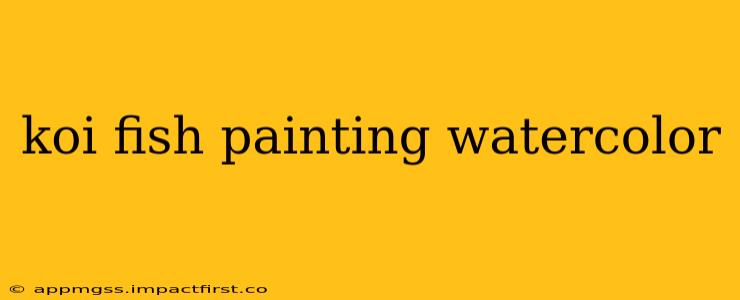The serene beauty of koi fish has captivated artists for centuries, and watercolor is a particularly fitting medium to capture their elegant movements and vibrant colors. This comprehensive guide will explore the techniques and considerations involved in creating a captivating watercolor painting of koi fish, from initial sketching to final touches. Whether you're a seasoned artist or just beginning your watercolor journey, this guide will provide valuable insights and inspiration.
What are the best watercolor papers for painting koi?
Choosing the right watercolor paper is crucial for a successful painting. Heavier weight papers, typically 140lb (300gsm) or higher, are recommended for watercolor painting, especially for detailed subjects like koi fish. These papers can withstand multiple layers of washes and prevent buckling. Cold-pressed paper, with its slightly textured surface, is a popular choice for its ability to hold both washes and fine details. Hot-pressed paper provides a smoother surface, ideal for very fine details, but might be less forgiving for beginners.
How do I mix watercolor paints to achieve realistic koi colors?
Koi fish exhibit a breathtaking range of colors, from deep blacks and oranges to shimmering metallic golds. Achieving realistic colors requires careful mixing of your watercolor paints. Start with a limited palette of primary colors (cadmium red, yellow, and blue) and experiment with mixing different ratios to achieve the desired shades. For example, a rich orange can be created by mixing cadmium red and cadmium yellow, while a deep black often requires layering several colors, including indigo or ultramarine blue, and a touch of burnt umber. Don't be afraid to experiment—observing real koi fish or high-quality photographs will significantly aid in your color mixing.
What are some good techniques for painting koi scales?
Painting realistic koi scales is where the magic truly happens. Several techniques can achieve this. One popular method involves using a fine brush to carefully paint each scale individually. This is time-consuming but produces highly detailed results. Alternatively, you can use a wet-on-wet technique, where you apply wet paint to a wet surface, allowing the colors to blend softly, creating a more impressionistic effect. Another option is to use a lifting technique, where you remove paint from already-applied washes using a damp brush or tissue, to achieve a subtle scale-like effect.
How do I paint the koi's flowing movement in water?
Capturing the graceful movement of koi fish in water is essential to bringing your painting to life. This requires understanding the principles of negative space and suggesting movement rather than depicting it literally. Pay close attention to the flow of the water around the fish, leaving some areas blank to represent the transparency of the water. Utilize washes of varying intensities to suggest depth and movement. Subtle variations in color and value can dramatically impact the perceived movement of the fish.
What are some tips for beginners painting koi fish with watercolors?
Beginners often find that starting with a simple composition is key. Begin by sketching your koi in light pencil lines. Focus on basic shapes and forms before delving into intricate details. Use masking fluid to protect areas you want to remain white or light, such as highlights on the scales. Build up your layers gradually, allowing each wash to dry before applying the next. Don't be afraid to make mistakes; watercolor allows for experimentation and corrections. Above all, have fun and enjoy the process!
How do I add details to my watercolor koi painting?
Once the basic forms and colors are in place, you can start adding details to enhance your painting. Consider using a fine brush to paint individual scales, fins, and the koi's eyes. Adding subtle highlights and shadows will bring your subject to life. The addition of ripples and reflections in the water can add a dynamic quality to your painting, further emphasizing the fish's movement.
This comprehensive guide provides a solid foundation for creating your own stunning watercolor koi fish painting. Remember, practice and patience are key to mastering this art form. Embrace experimentation, learn from your mistakes, and most importantly, enjoy the creative journey!
